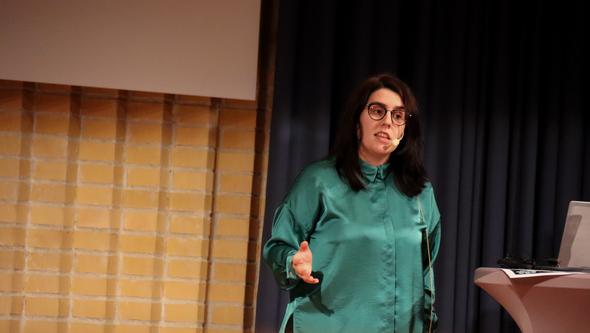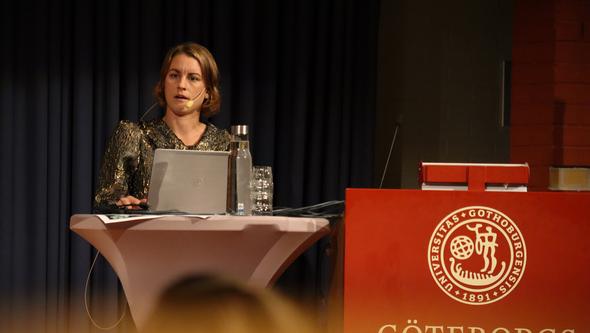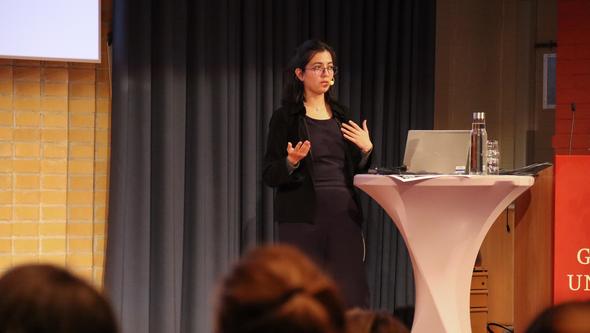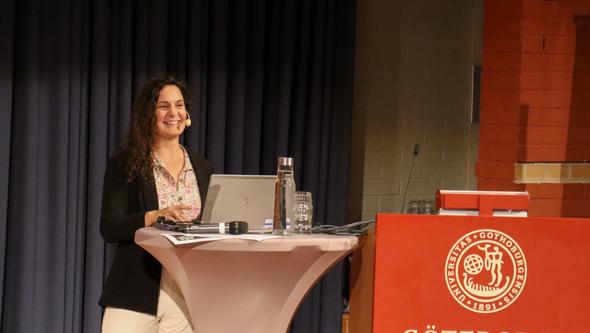
- Home
- News and events
- Find news
- Four Projects Selected After a Record Number of Applications for the Bollan Stipend 2022
Four Projects Selected After a Record Number of Applications for the Bollan Stipend 2022
After a thorough review process of over forty applications for the Bollan Stipend 2022, four young researchers at Sahlgrenska Academy have now been awarded the stipend for research projects in medicine and health. The funds are intended to be used within Core Facilities for design, analysis, data collection or other research support available at the research infrastructure.
Three out of the four projects have applied for the use of the expertise at EBM, and two projects combine several units within Core Facilities in their application.
Elisabet Carlsohn och Marie Hornfelt, Heads of Core Facilities, handed out the stipend together with representatives from the Lindén family.
“It is great to see that the interest for the stipend is so high among our young researchers,” said Marie.
“The quality of the projects and the applications also held a high standard,” Elisabet added.
Each application has first been assessed on the basis of practical feasibility by the Core Facilities unit managers, and then been reviewed by three reviewers from the various departments at Sahlgrenska Academy as well as representatives from Chalmers and VGR.
Presentation of this Year's Stipends

“Inflammatory bowel disease (IBD) is caused by bacteria that reach intestinal epithelial cells (IECs) and thereby trigger inflammation. We recently discovered a membrane mucin MUC17 that prevents bacterial attachment to IECs. However, the role of MUC17 in IBD and in mucosal defenses remains unexplored. We have now developed a new MUC17 knockout mouse that helps us understand how IECs combat harmful bacteria and whether defects in MUC17 contribute to IBD etiology. Ultimately, our research could result in new therapeutic approaches to treat IBD.”
Elena Layunta Hernandez, Institute of Biomedicine
SEK 75 000 to use at:
- Bioinformatics and Data Centre (BDC)
- Centre for Cellular Imaging (CCI)
- Experimental Biomedicine (EBM)
Project Title: Defining functional role of membrane mucins in mucosal barrier of the intestine
Project Summary: Gastrointestinal tract harbors trillions of bacteria that must be separated from intestinal epithelium. To this end, the intestinal epithelium produces protective mucus composed of gel-forming mucin MUC2 and a sugar-rich glycocalyx atop IECs composed of membrane mucin MUC17. Inflammatory bowel disease (IBD) is characterized by defects in mucosal barriers that allow bacteria to reach the epithelium and trigger inflammation. Despite advances in describing the protective functions of MUC2, the functions of MUC17 and glycocalyx remain entirely unexplored. Consequently, this project is significant on three levels. It will (1) define the impact of MUC17 on the glycocalyx barrier, (2) identify the involvement of MUC17 in the synthesis, release and stabilization of intestinal mucus and (3) determine how MUC17 controls intestinal microbiota. This proposal is timely and strategically important, and could reveal MUC17 as a key regulator in the mucosal barriers that enable our coexistence with bacteria.

“Osteoporosis increases risk of fractures, and patients with inflammatory diseases have increased risk to develop bone loss. Estrogen protects against bone loss but is not suitable as treatment due to adverse effects such as increased risk of cancer in reproductive tissues. The bone protective effects of estrogen are mainly mediated by estrogen receptor alpha (ERα), and by studying this, I hope to add important knowledge about the role of estrogen signaling in inflammatory diseases. This may lead to new treatment strategies against bone loss caused by inflammation, such as rheumatoid arthritis.”
Karin Horkeby, Institute of Medicine
SEK 55 000 to use at:
- Experimental Biomedicine (EBM)
Project Title: “Prevention of inflammatory bone loss by targeting cell-specific membrane estrogen receptor alpha signaling”.
Project Summary: Chronic inflammation is associated with decreased bone mass and increased fracture risk. Estrogen protects against inflammatory bone loss, but is not suitable as treatment due to adverse effects. In order to find better estrogen-like treatments for inflammatory bone loss, the mechanism of estrogen signaling needs to be clarified. Estrogen mediates its effects mainly through estrogen receptor alpha (ERα). Recently, we demonstrated that ERα located in the cell membrane mediates tissue-specific estrogen responses. In this project, I will determine the role of membrane ERα (mERα) signaling in estrogen’s protective effects against inflammatory bone loss and identify the target cells for this mERα signaling using novel transgenic mouse models. The experiments will be done at the core facility laboratory for experimental biomedicine and will include large breeding’s and extensive animal handling, that will be done by animal technicians at EBM.

“Streptococcus pneumoniae is the leading cause of pneumonia worldwide. The mortality rate was close to 1.2 million deaths in 2016, and a high percentage of carriers – between 27 and 65 percent across the globe, are children. In this study we will use state-of-the-art applications of mass spectrometry (MS) to better understand how the S. pneumoniae proteome changes while in contact with human cells, and how it varies in strains causing invasive and non-invasive infections.”
Leonarda Acha Alarcon, Institute of Biomedicine
SEK 55 000 to use at:
- Proteomics Core Facility (PCF)
Project Title: Virulence of streptococcus pneumoniae – comparison of differential protein expression levels of invasive vs non-invasive strains using quantitative proteomic”.
Project Summary: We will use novel, state-of-the-art applications of mass spectrometry (MS) and proteomic analyses for the identification of biomarkers applicable for species-level identification as well as detection of virulence factors signifying invasive strains of S. pneumoniae. To study virulence of S. pneumoniae we want to set up model systems including invasive strains vs non-invasive strains of S. pneumoniae and compare differential protein expression levels using quantitative proteomics approaches. We want to compare different sample preparation strategies, including whole-cell lysates and surface-shaving approaches, focusing of the surface proteome (surfaceome). While using the described strategies we aim to get a comprehensive panorama of the differences in protein expression between Streptococcus pneumoniae invasive vs non-invasive infections.

“In this project, I aim to neurochemically identify target cells of the hunger hormone ghrelin. Brain areas that contain ghrelin-responsive cells, are linked to the dopamine reward system, and by getting insights into these processes we can possibly find new treatments for obesity caused by overeating. According to WHO, 39 percent of the population in our society is overweight and risk common health issues like cardiovascular disease and diabetes.”
Iris Stoltenborg, Institute of Neuroscience and Physiology
SEK 55 000 to use at:
- Centre for Cellular Imaging (CCI)
- Experimental Biomedicine (EBM)
Project Title: Neurochemical identification of ghrelin-activated and/or ghrelin receptor-expressing neurons in brain areas connected to the dopamine reward system.
Project Summary: To date we have gained much insight regarding the brain pathways involved in feeding behaviour, yet the picture is far from complete. Expanding our knowledge of the orexigenic brain system can contribute to developing new treatments that help control appetite, which is urgently needed to fight the obesity pandemic. I aim to neurochemically identify target cells of the hunger hormone ghrelin, which plays a major role in orexigenic signalling. Combining novel tools, RNAscope and the TRAP2 mouse, makes it possible to genetically access ghrelin-activated neurones. First project: I aim to identify the cells in the Arcuate nucleus (a hub in the feeding circuitry) that are activated by ghrelin. Second project: I will explore the function and identity of ghrelin-targeted cells in other brain areas such as the ventral tegmental area and the lateral hypothalamus. Gained knowledge will hopefully lead to the discovery of druggable targets to treat obesity.